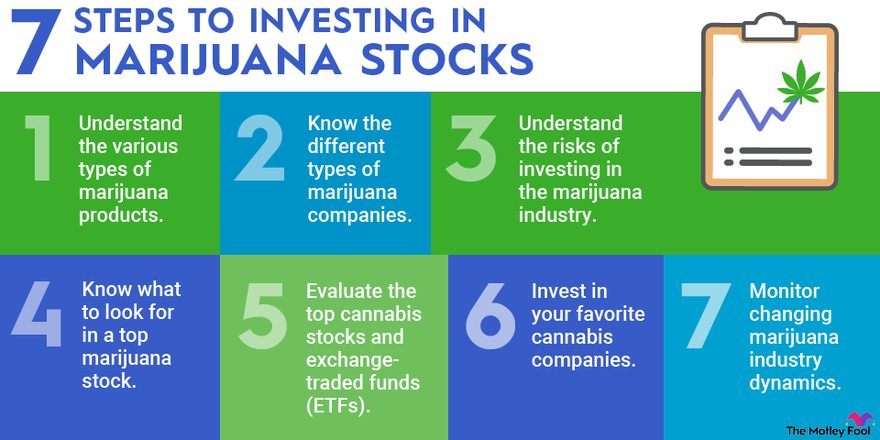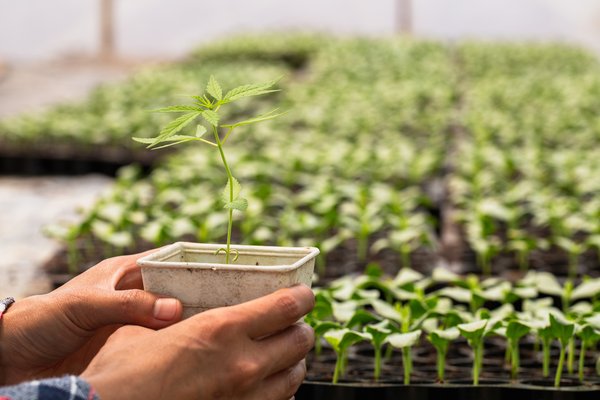Global marijuana markets are growing like a weed. The value of the worldwide legal cannabis market is projected to increase by a compound annual growth rate of 26.3% and to reach $91.5 billion by 2028, according to Grand View Market Research. With this impressive expected growth, it's no wonder that many investors are interested in owning cannabis stocks.
What's the best approach to marijuana stock investing? Follow these seven key steps to become a successful cannabis investor:

Here's everything you need to know about each of these seven steps.
1. Understand the various types of marijuana products.
1. Understand the various types of marijuana products.
There are two broad categories of cannabis products:
- Medical marijuana: Medical marijuana, which is cannabis used for medicinal purposes, is legal in 36 U.S. states, plus the District of Columbia, and in more than 40 countries. A prescription from an authorized healthcare provider is typically required for patients to obtain medical marijuana. Medical cannabis is frequently prescribed to adults for anxiety, depression, pain, and stress.
- Recreational marijuana: Eighteen U.S. states, plus Washington, D.C., have legalized recreational marijuana for adult use. Recreational marijuana is also legal in Canada, Georgia, Malta, Mexico, South Africa, and Uruguay.
2. Know the different types of marijuana companies.
2. Know the different types of marijuana companies.
The three primary types of companies in the marijuana industry are:
- Cannabis growers and retailers: These companies cultivate cannabis (often in indoor facilities and greenhouses), harvest the crops, and distribute the end products to customers. Some also operate retail stores that sell medical and/or recreational cannabis.
- Cannabis-focused biotechnology companies: Some biotech companies participate in the cannabis industry by extracting cannabinoids from marijuana to develop new pharmaceutical drugs.
- Ancillary product and service providers: These companies don't touch the plants but support the marijuana industry by providing products and services such as hydroponics products, lighting systems, packaging materials, and management services.
3. Understand the risks
3. Understand the risks of investing in the marijuana industry.
Investing in any type of asset comes with some degree of risk. Investing in marijuana stocks is associated with additional specific risks that you should clearly understand:
- Legal and political risks: Selling marijuana remains illegal at the federal level in the U.S. In addition, U.S. federal law places severe restrictions on banks that deal with marijuana-related businesses. As a result, it's difficult for U.S. cannabis businesses to access critical financial services. Political support has increased for federally legalizing or decriminalizing marijuana, but there's no guarantee that either action will occur.
- Supply and demand imbalances: As a burgeoning industry in the agriculture sector, marijuana is particularly prone to irregularities in supply and demand. Canadian marijuana growers initially undertook major expansion initiatives to increase production capacity in order to meet recreational marijuana demand. Some companies later cut back on production because cannabis supply in Canada outstripped demand, causing prices to fall and revenue to suffer.
- Over-the-counter (OTC) stock risks: Many cannabis companies trade on OTC markets. That means they are not required to regularly file financial statements, which are important for investors wishing to assess the risk of a stock. Companies that trade OTC also don't have to maintain minimum market capitalizations, which can result in low levels of liquidity and make the cannabis stock difficult to trade.
- Financial constraints: Many cannabis industry participants are unprofitable growing companies that face the prospect of running out of cash. They often raise capital by issuing new shares, which dilutes the value of the existing shares. Even with this dilution, financially constrained marijuana companies can struggle to obtain enough capital to successfully operate.
4. Know what to look for
4. Know what to look for in a top marijuana stock.
When considering any marijuana stock, you should:
- Research the management team.
- Understand the company's growth strategy and competitive position.
- Scrutinize the company's financial statements.
- Examine how many warrants and convertible securities the company has issued. A high number on a percentage basis could mean that the stock will be meaningfully diluted in the future, potentially causing the share price to drop substantially.
For marijuana growing companies, specific metrics to research include:
- All-in cost of sales per gram: A company's total per-gram cost of producing cannabis.
- Cash cost per gram: A company's total per-gram cost of producing cannabis, excluding the costs associated with amortization, packaging, and inventory adjustments.
You can look for and prioritize marijuana growers with lower cost structures since they tend to be the most competitive.
5. Evaluate the top cannabis stocks and ETFs.
5. Evaluate the top cannabis stocks and ETFs.
Now for the fun part: digging into the top marijuana companies. You might also want to check out marijuana-focused exchange-traded funds (ETFs).
Below is a list of top marijuana stocks to thoroughly consider. Note that this collection isn't comprehensive and includes only marijuana stocks with market caps of at least $200 million.
| Marijuana Company Type | Marijuana Company Name | Market Capitalization |
|---|---|---|
| Cannabis growers and retailers | Curaleaf Holdings (OTC:CURLF) | $3.5 billion |
| Cannabis growers and retailers | Trulieve Cannabis (OTC:TCNNF) | $1.65 billion |
| Cannabis growers and retailers | Green Thumb Industries (OTC:GTBIF) | $2.3 billion |
| Cannabis growers and retailers | Canopy Growth Corporation (NASDAQ:CGC) | $1.3 billion |
| Cannabis growers and retailers | Tilray (NASDAQ:TLRY) | $2.0 billion |
| Cannabis growers and retailers | Cresco Labs (OTC:CRLBF) | $751 million |
| Cannabis growers and retailers | Cronos Group (NASDAQ:CRON) | $1.1 billion |
| Cannabis growers and retailers | Aurora Cannabis (NASDAQ:ACB) | $324 million |
| Cannabis growers and retailers | Sundial Growers (NASDAQ:SNDL) | $535 million |
| Cannabis growers and retailers | Ayr Wellness (OTC:AYRW.F) | $122 million |
| Cannabis growers and retailers | Jushi Holdings (OTC:JUSHF) | $257 million |
| Cannabis growers and retailers | Planet 13 Holdings (OTC:PLNH.F) | $236 million |
| Cannabis growers and retailers | Village Farms International (NASDAQ:VFF) | $559 million |
| Cannabis growers and retailers | OrganiGram (NASDAQ:OGI) | $136 million |
| Cannabis growers and retailers | HEXO (NASDAQ:HEXO) (TSX:HEXO) | $68 million |
| Biotechnology companies | Jazz Pharmaceuticals (NASDAQ:JAZZ) | $9.7 billion |
| Biotechnology companies | Cara Therapeutics (NASDAQ:CARA) | $604 million |
| Ancillary providers | Scotts Miracle-Gro (NYSE:SMG) | $2.7 billion |
| Ancillary providers | Innovative Industrial Properties (NYSE:IIPR) | $3.1 billion |
| Ancillary providers | GrowGeneration (NASDAQ:GRWG) | $308 million |
| Ancillary providers | WM Technology (NASDAQ:MAPS) | $181 million |
Here are a couple of marijuana ETFs to also consider adding to your portfolio:
| Marijuana ETF | Assets Under Management |
|---|---|
| ETFMG Alternative Harvest ETF (NYSEMKT:MJ) | $412 million |
| Horizons Marijuana Life Sciences ETF (OTC:HMLSF) | N/A |
6. Invest in your favorite cannabis companies.
6. Invest in your favorite cannabis companies.
Investing in marijuana companies is not suitable for everyone. For some, particularly conservative investors, the best approach is to avoid these types of stocks entirely. Only investors who understand and can tolerate high levels of risk should add cannabis companies to their portfolios.
Even for aggressive investors, putting too much of your investment portfolio into any one marijuana stock or ETF isn't wise. Consider starting with a small position in a marijuana stock and adding to your holdings as the cannabis market grows and the company increases its revenue and earnings. The investment becomes less risky as your investment thesis is confirmed, but if the company instead performs poorly, you should reevaluate your investment assumptions.
When choosing which cannabis stocks to buy, remember that some stocks are arguably safer than others. For example, Scotts Miracle-Gro, which historically sells lawn and garden products, makes much of its revenue from outside the cannabis industry. Therefore the company doesn't face many of the risks normally associated with cannabis products and could be a better choice for more conservative investors.
Related investing topics
7. Monitor changing marijuana industry dynamics.
7. Monitor changing marijuana industry dynamics.
While investors are generally advised to take a long-term view when buying stocks, the dynamics of the marijuana industry are rapidly changing. The criteria you should use today to make a stock-buying decision could be dramatically different in just a few months.
Marijuana industry investors should closely monitor any marijuana stocks or ETFs in their portfolios, along with the overall industry itself. Some changes -- such as if the U.S. federal government relaxed its marijuana laws -- would be beneficial, while other changes could be devastating.
Tremendous growth is likely for the global marijuana industry, but it may not occur evenly or predictably. Following these seven steps for investing in marijuana stocks can help you to navigate investing in this exciting and challenging industry.










